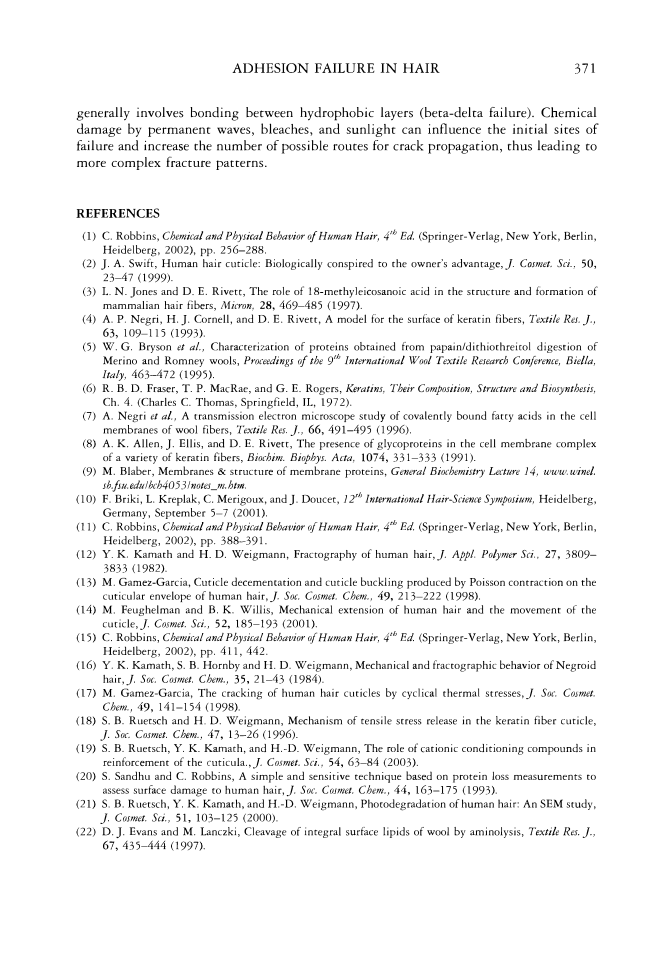370 JOURNAL OF COSMETIC SCIENCE \ J ...,Peptide, Hydrogen g' Bonds & Salt Links 00dl8 ° ° 0 .£._..peptide Bonds and van der Waals ---van der Waals S-CH2-C02- f=0 f=O =0 \ 1 Peptide, Hydrogen �Bonds & Salt Links oo�o 0 00 0 0 0 �eptide Bonds � and van der Waals � � � � f --¥an der Waals C=O f=O f=O _ "s-CH2-C02- � Figure 20. Reactions of the thioester linkage with TGA in the upper beta layer. \ J ...,Peptide, Hydrogen "7' Bonds & Salt Links oon s 0 OQ (1 Q .£._.peptide Bonds and van der Waats ---van der Waals S-CH2-C02- r=0 r=O =0 J Yeptide, Hydrogen -----::::::,.,,'Bonds & Salt Links oon s 0 OOry o�eptideBonds and van der Waals �an der Waals ._- ... ... .. ...----_rJ•.1•.• .. -. Figure 21. Reactions of thioester with TGA followed by quat & anionic in this same layer. cracks during heat drying, scale lifting by surfactants, and catastrophic failure. Failure in the wet state generally involves hydrophilic layers (endocuticle or the contact zone of the CMC) or bonding between hydrophilic layers, whereas failure in the dry state
ADHESION FAILURE IN HAIR 371 generally involves bonding between hydrophobic layers (beta-delta failure). Chemical damage by permanent waves, bleaches, and sunlight can influence the initial sites of failure and increase the number of possible routes for crack propagation, thus leading to more complex fracture patterns. REFERENCES (1) C. Robbins, Chemical and Physical Behavior of Human Hair, 4th Ed. (Springer-Verlag, New York, Berlin, Heidelberg, 2002), pp. 256-288. (2) J. A. Swift, Human hair cuticle: Biologically conspired to the owner's advantage,]. Cosrnet. Sci., 50, 23-47 (1999). (3) L. N. Jones and D. E. Rivett, The role of 18-methyleicosanoic acid in the structure and formation of mammalian hair fibers, Micron, 28, 469-485 (1997). (4) A. P. Negri, H.J. Cornell, and D. E. Rivett, A model for the surface of keratin fibers, Textile Res.]., 63, 109-115 (1993). (5) W. G. Bryson et al., Characterization of proteins obtained from papain/dithiothreitol digestion of Merino and Romney wools, Proceedings of the 9th International Wool Textile Research Conference, Biel/a, Italy, 463-472 (1995). (6) R. B. D. Fraser, T. P. MacRae, and G. E. Rogers, Keratins, Their Composition, Structure and Biosynthesis, Ch. 4. (Charles C. Thomas, Springfield, IL, 1972). (7) A. Negri et al., A transmission electron microscope study of covalently bound fatty acids in the cell membranes of wool fibers, Textile Res.]., 66, 491-495 (1996). (8) A. K. Allen, J. Ellis, and D. E. Rivett, The presence of glycoproteins in the cell membrane complex of a variety of keratin fibers, Biochirn. Biophys. Acta, 1074, 331-333 (1991). (9) M. Blaber, Membranes & structure of membrane proteins, General Biochemistry Lecture 14, www. wine/. sb.fsu. edu! bch40 5 3 !notes_rn. htrn. (10) F. Briki, L. Kreplak, C. Merigoux, and]. Doucet, 12th International Hair-Science Symposium, Heidelberg, Germany, September 5-7 (2001). (11) C. Robbins, Chemical and Physical Behavior of Human Hair, 4th Ed. (Springer-Verlag, New York, Berlin, Heidelberg, 2002), pp. 388-391. (12) Y. K. Karnath and H. D. Weigmann, Fractography of human hair,]. Appl. Polymer Sci., 27, 3809- 3833 (1982). (13) M. Gamez-Garcia, Cuticle decementation and cuticle buckling produced by Poisson contraction on the cuticular envelope of human hair,]. Soc. Cosrnet. Chern., 49, 213-222 (1998). (14) M. Feughelman and B. K. Willis, Mechanical extension of human hair and the movement of the cuticle,]. Cosrnet. Sci., 52, 185-193 (2001). (15) C. Robbins, Chemical and Physical Behavior of Human Hair, 4th Ed. (Springer-Verlag, New York, Berlin, Heidelberg, 2002), pp. 411, 442. (16) Y. K. Karnath, S. B. Hornby and H. D. Weigmann, Mechanical and fractographic behavior of Negroid hair,]. Soc. Cosmet. Chem., 35, 21-43 (1984). (17) M. Gamez-Garcia, The cracking of human hair cuticles by cyclical thermal stresses,]. Soc. Cosmet. Chem., 49, 141-154 (1998). (18) S. B. Ruetsch and H. D. Weigmann, Mechanism of tensile stress release in the keratin fiber cuticle, ]. Soc. Cosmet. Chern., 47, 13-26 (1996). (19) S. B. Ruetsch, Y. K. Karnath, and H.-D. Weigmann, The role of cationic conditioning compounds in reinforcement of the cuticula.,]. Cosmet. Sci., 54, 63-84 (2003). (20) S. Sandhu and C. Robbins, A simple and sensitive technique based on protein loss measurements to assess surface damage to human hair,]. Soc. Cosmet. Chem., 44, 163-175 (1993). (21) S. B. Ruetsch, Y. K. Karnath, and H.-D. Weigmann, Photodegradation of human hair: An SEM study, ]. Cosmet. Sci., 51, 103-125 (2000). (22) D. J. Evans and M. Lanczki, Cleavage of integral surface lipids of wool by aminolysis, Textile Res.]., 67, 435-444 (1997).
Purchased for the exclusive use of nofirst nolast (unknown) From: SCC Media Library & Resource Center (library.scconline.org)






































































































